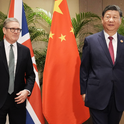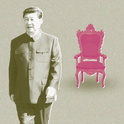A statue of former Turkmenistan dictator Saparmurat Niyazov ©Robert Preston/Age Fotostock/Superstock
The President of the World Bank, Jim Yong Kim, visited China in 2012. While there, he spoke of China’s economic success in delivering “on truly aspirational goals,” and went on to announce a World Bank programme to spread “practical knowledge from China’s successes in reducing poverty.” More recently, the World Bank’s report on China’s future, “China 2030: Building a Modern, Harmonious, and Creative Society,” closed with a sentence giving credit for positive results to the Chinese leadership, celebrating their “wisdom, strength, and determination.”
Intellectual leaders have been similarly effusive about China’s progress. New York Times columnist Thomas Friedman said: “One-party autocracy certainly has its drawbacks. But when it is led by a reasonably enlightened group of people, as China is today, it can also have great advantages. That one party can just impose the politically difficult but critically important policies needed to move a society forward in the 21st century.”
These are examples of the most persistent myth in economic development—that autocratic governments create growth miracles; that great leaderships, free from messy democratic constraints, produce high economic growth through their own commitment to development. But this is a myth, and one that reinforces the mainstream approach to ending global poverty which sees development as a series of technical, structural, topdown adjustments.
Autocratic growth miracles may at first seem persuasive—just look at the remarkable economic growth that occurred under Deng Xiaoping in China, under the single-party leaderships of Lee Kuan Yew in Singapore and of Park Chung Hee in South Korea. But it takes some work to understand that these claims are not quite what they seem.
Examples such as this convince a lot of development agencies and professionals. Notable development economists Nancy Birdsall and Francis Fukuyama noted in 2011 (they make clear they are summarising others’ views, not their own view): “Leaders in both the developing and the developed world have marvelled at China’s remarkable ability to bounce back after the [2008] crisis, a result of a tightly managed, top-down policymaking machine that could avoid the delays of a messy democratic process. In response, political leaders in the developing world now associate efficiency and capability with autocratic political systems.”
It is not only China that enjoys this status. The belief in authoritarian miracles has spread more recently to Africa, with Ethiopia’s late Meles Zenawi and Rwanda’s Paul Kagame celebrated for high growth during their autocratic tenures. For example, the UK’s Department for International Development wrote in its 2013 annual report that “Ethiopia has experienced impressive growth and development in recent years.” The United States Agency for International Development is now sure that “Ethiopia” (meaning its highly repressive government) is transforming “its economy and society toward middle income status.” Kim joined the chorus celebrating Ethiopia’s “transformational change,” which he attributed to a “stable” government that pursues “prudent economic policies,” and takes “a long-term perspective.”
The first dent in the evidence for benevolent autocracy is another piece of evidence: autocrats also presided over most of the world’s recent growth disasters. The list of autocratic disasters is as long as that of autocratic miracles: Robert Mugabe in Zimbabwe, Kim Il-sung and offspring in North Korea, Joseph Mobutu in Zaire, Ferdinand Marcos in the Philippines, Idi Amin in Uganda, Kenneth Kaunda in Zambia, Jean-Bédel Bokassa in the Central African Republic, Julius Nyerere in Tanzania, and many other lesser-known despots.
Some economists like Dani Rodrik at the Institute for Advanced Study interpret this evidence as suggesting that autocracy is like a very risky bet. You can win big with Lee Kuan Yew, or you could lose it all with Robert Mugabe.
Yet even this is too quick to give credit to those autocrats presiding over high growth. We need to consider first whether there are alternative explanations for the high growth occurring under some autocrats, and then consider which explanations the evidence supports.
Another well-known fact about economic growth is that poor countries have more extreme outcomes than rich countries. The best growth rates of poor countries are better than the best growth of rich countries, while the worst growth of the poor nations is also worse than the worst growth of the rich. This fact already carries a common explanation: the promise and peril of technological catching-up. Poor countries are technologically backward. This gives them a potential for rapid growth due to the “catch-up” advantage that they can cheaply imitate technologies already invented in rich countries. It pays off a lot more to jump from a manual typewriter to an iPad than it does to go from an iPad 4 to an iPad Air.
Technological backwardness does not automatically confer catch-up growth on poor countries, however. If technologically backward countries fail to imitate and adopt the continuing stream of advanced technologies invented in rich countries, they will fall even further behind the rich countries.
The other obvious fact is that most poor countries have autocratic rulers, an important piece of evidence in itself. This fact means that autocratic rulers will be on the scene during rapid technological catch-up as well as during technological falling- behind—because catch-up only happens in poor countries, which also tend to have dictators.
These dictators are accidental and irrelevant to the process of technological catch-up. How much technology has been invented or adopted is related to the freedom for individuals to challenge the conventional wisdom by adopting new ideas and technologies. The scientific and technological enlightenment that began in the late 18th century in the west was related to the political enlightenment and its core notion of individual freedom. Joel Mokyr, the economic historian, quotes the philosopher Immanuel Kant’s summary of the Enlightenment as “dare to know,” or what Mokyr jokes is its bumper sticker equivalent: “challenge authority.” Individuals’ freedom to choose investments and keep the rewards makes them more likely to invest in technology, and in machinery and education. And political freedom allows individuals to demand that the government provide them with the infrastructure, schooling, and public health services to complement these private investments; free individuals can protest and vote officials out of office when they fail to deliver good quality public services.
As a consequence, the amount of political and economic freedom enjoyed by individuals around the world is correlated with both their level of advanced technology and their income per person. There are difficulties about proving which causes which (does freedom cause riches or do rich people demand freedom?) But this long-run correlation makes it more difficult to argue that autocracy is the fount of prosperity. The fact that poor countries lack political and economic freedom seems to have a lot to do with them being poor in the first place.
If the story about the level of freedom driving the level of prosperity is correct, then a change in freedom should be associated with a change in prosperity. Rapidly increasing freedom (or a falling degree of autocracy) should be associated with rapid economic growth. So we have been asking the wrong question about autocratic growth miracles. We should not ask whether growth miracles happen under autocrats, we should ask whether growth miracles happen when these autocrats are becoming less autocratic. The answer is usually “yes.”
To take everyone’s favourite example, China has actually had a strong positive change in both political and economic freedom since the death of Mao. Mao and cronies created recurrent terror, the Great Famine, and the Cultural Revolution, which destroyed incentives for individuals to invest in their futures. Chinese citizens today enjoy stronger rights than they did in those dark days, most obviously in economic rights. Even political and personal rights, while well short of a good level of freedom, do qualify as a positive change. A contender for explaining the Chinese growth miracle is simply that the economy has had a large positive response to a large positive change in freedom
Chinese farmers had been trying for years to evade their obligations to produce for the collective farm and to increase their production on their own family plots. Brutal force under Mao at the height of the Cultural Revolution had enforced collective farming, but the cost was anemic crop production.
After Mao’s death in 1976, a less ruthless power at the centre granted farmers an opening. They could bribe the local party cadres to overlook switching some of their time to their family plots. One farmer couple in a poor village in Heilongjiang province wrote to their local party cadre: “no one wants us because we are so poor. We have an idea to get rid of poverty—which is to divide the land and allocate it to the household. We will pay 4.5 yuan per mu [15 mu = 1 ha.] to the [collective team], if the team leaves us alone.”
These deals happened most where farmers were under severe pressure from drought and famine, such as in Anhui and Sichuan provinces in the late 1970s. Cadres either sympathised or were simply happy to increase their own incomes from farmers’ bribes. As family farming paid off for both farmers and local cadres, it spread in a decentralised, chaotic way. It was not until 1982 that a central party document recognised the reality and acknowledged family farming “as one of the responsibility systems of the socialist collective economy.”
****
So there at least two other competing stories for autocratic growth miracles: one is that they reflect long-run technological catching-up and the other that they reflect a longrun reduction in autocracy, even while the leader during the rapid growth is still an autocrat. Which stories are most consistent with the evidence?
Let’s give those alleged miracle-producing leaders their own shot at the growth evidence. Let’s look at the timing of growth booms and busts to see if they coincide with times when an autocrat is in power. If most of the big changes in growth happen when autocrats change, that is evidence for big effects of particular, individual autocrats on growth (either positive or negative). If most of the big changes in growth happen when there has been no change in leadership, however, this suggests that individual autocrats do not matter so much as other conditions for growth.
This will help to distinguish leaders’ roles from the countries’ roles in growth rates. To put it another way, if all of the leaders in a given country achieve high growth, that is really evidence that the country itself matters more than the leaders. For example, the list of high-performing leaders includes three different leaders from South Korea: the dictators Park Chung Hee and Chun Doo Hwan, and Roh Tae Woo who oversaw a transition to democracy. Together, these three leaders account for most of South Korea’s growth data, so it seems more likely that conditions in South Korea mattered more than did the character of any of the individual leaders.
There could also be regional effects. It seems too much of a coincidence that most growth miracles are in east Asia (China, Hong Kong, Singapore, South Korea, Taiwan, not to mention the earlier miracle of Japan). Regional growth miracles imply a role for transnational forces that leave an even smaller possible role for national autocrats.
Technological catch-up often spreads from nearby countries which have already adopted some of the new technologies. Regions could also matter because they bring some economic freedoms (such as freedom to trade and migrate). Just look at the amazing role of the overseas Chinese diaspora in east Asia. The diaspora moved themselves or their investments back and forth from China to Hong Kong, Singapore, and Taiwan, while also trading amongst themselves or with other regional powerhouses Japan and South Korea.
So what does the evidence say? My co-author Steven Pennings and I crunched the numbers in a paper and the data showed little evidence that leaders matter for growth rates. The timing of changes in growth simply do not match the timing of leadership changes. Many of our estimates of the effect of leaders on growth using alternative datasets and methods are close to zero, which myself and Pennings find almost too shocking to be believed. Even allowing for a margin of error, the evidence suggests that the effects of leaders are small. The autocratic leadership of nations can take very little of the credit for growth rates.
The boom-and-bust nature of growth rates explains why there would be so many spurious attributions of growth to leaders, even when leader effects are small or nonexistent. Some leaders just get lucky to have part of a boom happen while they are in office. But often, the timing of the boom began before they took office, or ended after they left office, so the boom itself provides no evidence that their leadership mattered at all. But even having part of a boom while these lucky leaders are in office is enough to inflate the average growth during their terms, and so they spuriously get credit for high growth.
The evidence also confirms that an important part of good or bad growth is really down to national or regional effects. The long-run evidence is more consistent with the countryor region-based stories for major growth successes like China, South Korea or Taiwan, which illustrate technological catchup growth potential and the impact of a positive trends toward greater freedom.
So we have held a fair trial for autocrats accused of causing growth miracles, and they have been found innocent. Political strongmen play no part in the economic growth that occurs on their watch.
Alas, the prevalent misuse of evidence to give credit for growth to autocrats has bad consequences for development practices. Apparently infatuated with rapid growth under Ethiopia’s dictators, the World Bank’s Ethiopia web page in September 2012 noted that it was “Ethiopia’s largest provider of official development assistance.” The Bank said it was “partnering with GoE [Government of Ethiopia] to look for pragmatic solutions” in support of the latter’s “public sector-led growth strategy.” The Bank would help “the GoE to improve public service performance management and responsiveness,” launching a “Public Sector Capacity Building Programme.” The GoE had committed to reforms including “democratic representation” and “human rights and conflict prevention,” commitments which the GoE would strictly enforce upon itself.
The GoE actually had a long record of human rights abuses, including killing demonstrators in the streets in 2005, denying donor-financed famine relief to opposition party members in 2010, and forcibly seizing farmers’ lands to sell to foreign companies in 2011. Less than two months before the World Bank statements in the previous paragraph, on 13th July 2012, the GoE sentenced the Ethiopian blogger and journalist Eskinder Nega to 18 years in prison. The sentence punished crimes including reporting the democratic aspirations of the Arab Spring.
Mentioning democratic aspirations is something of which Robert Zoellick, World Bank President from 2007 to 2012, was entirely innocent. Zoellick managed to give a whole speech on the Arab Spring on 6th April 2011 without ever using the word “democratic.” In fact, systematic monitoring of his speeches during his entire five-year term shows that he never used the word “democracy” in any of its normal variants. We have already seen how his successor as World Bank President, Jim Kim, was enthusiastic about what he thought were the achievements of Chinese autocracy.
****
The World Bank and many other parts of the development establishment are backing the wrong side: the autocratic oppressors instead of the oppressed, the side associated with long-run poverty rather than the side associated with long-run prosperity, the side that violates individual rights rather than the side pursuing those rights as a desirable end in and of themselves.
The development experts’ authoritarian infatuation partly reflects the mistaken interpretations of evidence discussed here. It may also reflect the appeal to western experts of unconstrained leaders who give such experts a greater ability to dictate solutions than democracies would. Of course, this tyranny of experts probably also reflects the political convenience of rationalising autocratic rulers whom the west wants as allies anyway—in today’s war on terror, just as in yesterday’s Cold War.
Yet hope remains. There are other forces in the world than western foreign policy interests and western development experts. There are those around the world campaigning for individual liberation in the “rest” as well as in the west, campaigning for rights for the poor as well as for the rich, campaigning for the values that all men and women are created equal.












